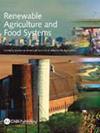Cropping systems alter plant volatile emissions in the field through soil legacy effects
IF 2
3区 农林科学
Q2 AGRICULTURE, MULTIDISCIPLINARY
引用次数: 2
Abstract
Abstract Crops emit a variety of volatile organic compounds (VOCs) that serve as attractants or repellents for pests and their natural enemies. Crop rotations, off-farm chemical inputs, and mechanical and cultural tactics – collectively called cropping systems – alter soil nutrients, moisture content, and microbial communities, all of which have the potential to alter crop VOC emissions. Soil legacy effects of diversified cropping systems have been shown to enhance crop VOC emissions in greenhouse studies, but how they influence emissions under field conditions remains virtually unknown. To determine the effect of cropping systems on plant VOC emissions in the field, air samples were collected from the headspace of wheat (Triticum aestivum L. Judee) grown in simplified wheat-fallow rotations or diversified wheat-cover crop rotations where cover crops were terminated by grazing cattle. Across two growing seasons, wheat grown in rotation with fallow emitted greater amounts of Z-3-hexenyl acetate and β-ocimene, key attractants for wheat stem sawfly (Cephus cinctus Norton), a major pest of wheat. While overall VOC blends were relatively similar among cropping system during the first growing season, emissions varied substantially in the second year of this study where wheat grown in rotation with cover crops emitted substantially greater quantities of volatile compounds characteristic of abiotic stress. Below-average precipitation in the second growing season, in addition to reduced soil water content in cover crop rotations, suggests that cropping system effects on wheat VOCs may have been driven primarily by water availability, a major factor limiting crop growth in dryland agriculture. While the specific mechanisms driving changes in VOC emissions were not explicitly tested, this work shows that agricultural practices applied in one growing season can differentially influence crop VOC emissions in the next through soil legacy effects, illustrating additional avenues through which cropping systems may be leveraged to enhance pest management.种植系统通过土壤遗留效应改变田间植物的挥发性排放
农作物会释放出多种挥发性有机化合物(VOCs),作为害虫及其天敌的引诱剂或驱避剂。作物轮作、非农化学投入、机械和文化策略——统称为种植系统——改变了土壤养分、水分含量和微生物群落,所有这些都有可能改变作物挥发性有机化合物的排放。在温室研究中,多样化种植制度的土壤遗留效应已被证明会增加作物挥发性有机化合物的排放,但它们如何影响田间条件下的排放仍然几乎未知。为了确定耕作制度对农田植物VOC排放的影响,在简化小麦-休耕轮作或多样化小麦-覆盖轮作(覆盖作物被放牧终止)中种植的小麦(Triticum aestivum L. Judee)的顶空收集了空气样本。在两个生长季节中,休耕轮作的小麦释放出更多的z -3-己烯乙酸酯和β-辛烯,这两种物质是小麦主要害虫麦秆锯蝇(Cephus cintus Norton)的主要引诱剂。虽然在第一个生长季节,各种植系统之间的VOC混合物总体上相对相似,但在本研究的第二年,与覆盖作物轮作的小麦排放的挥发性化合物的数量明显增加,这是非生物胁迫的特征。第二生长季降水低于平均水平,加上轮作时土壤含水量降低,表明耕作制度对小麦挥发性有机化合物的影响可能主要是由水分有效性驱动的,而水分有效性是限制旱地农业作物生长的一个主要因素。虽然没有明确测试驱动挥发性有机化合物排放变化的具体机制,但这项工作表明,在一个生长季节应用的农业实践可以通过土壤遗留效应对下一个生长季节的作物挥发性有机化合物排放产生不同的影响,这说明了利用种植系统来加强害虫管理的其他途径。
本文章由计算机程序翻译,如有差异,请以英文原文为准。
求助全文
约1分钟内获得全文
求助全文
来源期刊

Renewable Agriculture and Food Systems
农林科学-农业综合
CiteScore
5.20
自引率
7.40%
发文量
39
审稿时长
>36 weeks
期刊介绍:
Renewable Agriculture and Food Systems (formerly American Journal of Alternative Agriculture) is a multi-disciplinary journal which focuses on the science that underpins economically, environmentally, and socially sustainable approaches to agriculture and food production. The journal publishes original research and review articles on the economic, ecological, and environmental impacts of agriculture; the effective use of renewable resources and biodiversity in agro-ecosystems; and the technological and sociological implications of sustainable food systems. It also contains a discussion forum, which presents lively discussions on new and provocative topics.
 求助内容:
求助内容: 应助结果提醒方式:
应助结果提醒方式:


